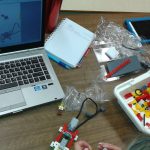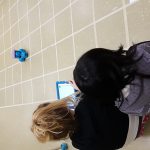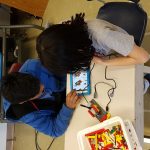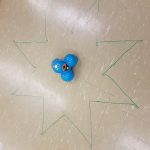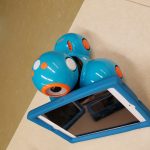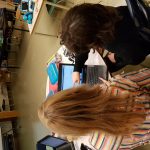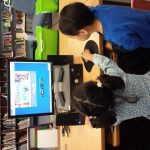Based on school data from EQAO and report cards, we have identified spatial reasoning as an area for improvement. Teachers and students will learn how to code (using Dash Robots, LEGO WeDo, EV3s, various apps, etc.) as a tool for learning. The teachers will engage in professional learning opportunities on how to use the various coding apps and tools, the school will purchase supporting technology, the teachers will collaborate with a lead teacher to support implementation in class, and share learning with parents through a technology night.
Team Members
Michelle Doyl
Toronto District School Board
Elitha Sims
Toronto District School Board
Trisha Babits
Toronto District School Board
Manju Sati
Toronto District School Board
Professional Learning Goals
Our school had a main goal to have each teacher and child involved in coding from the kindergarten to Grade 6 level, including our special education classes. The leadership team involved in this project ordered materials and learned together about how to code, collaborate on creating benchmarks for each division, including the special education classes, and provide professional learning for the rest of the staff/students in classrooms and through teacher/librarian partnering. All students will have the ability to access coding in ways that are appropriate for their grade and ability level (e.g., computers, laptops, SmartBoard, iPad mini or large iPad).
Personal Teacher Learning Goals:
Team Leader/Teacher Librarian – Throughout this experience, my goal as the lead teacher was to build a comfort level, knowledge base and openness to bringing technology and coding into the classroom. Building capacity throughout the school was important, and through numerous PLC meetings we were able to work together to grow our understanding of the importance and vast amount of opportunities it lends to connecting with the curriculum.
Primary teacher – My personal goal was to increase student engagement in coding apps, computer programs that were thoughtful and purposeful and that I was able to assess for student learning. I wanted to be able to share with parents the reasoning behind teaching children coding and the use of technology for more than just games. I wanted to be able to relay to parents the skills that children were working on such as perseverance and the ability to make edits to their code. Students have to use positional language and mathematical thinking in order to get to the end of an activity. I tried to focus also on the ability of students to learn and then be able to teach one another in a multi-grade grouping. Some students have an amazing ability to use technology in successful ways and then to have them be leaders in their class has been a wonderful experience for myself as a teacher and for students to teach one another.
Junior MID Teacher – I think having learning goals that kept the students in the middle of the action was awesome. This project provided opportunities for hands-on learning that allowed the students to learn with manipulatives and then apply computer technology. I think the ability to provide our students and teachers with opportunities to bring something into the learning classroom that every member, teacher and student could learn about together was authentic. My goal for the year was to engage alongside the students and build learning communities and opportunities for us all to be in relationship. Having worked on a team with other educators, I think it was important to have the team teaching approach. Also I think it is critical to include our educators who are support staff in the professional learning. I was very happy that they also had opportunity to learn too! I love that EVERY student was given an opportunity. This model supported authentic integration opportunities for all.
Additional Staff who Also Learned Coding:
Grade 2/3 Teacher – My goal was to first receive partnering time to get more help with this technology implementation and to have an experienced tech teacher to guide the learning. I also wanted to try the robots and get familiar with the coding websites such as code.org and Scratch, as well as the LEGO. My students have been catching on at an exponential level (some of them) so partnering was important to guide those learners.
Grade 2/3 Teacher – My personal goal was to learn more about coding and how it can be implemented into the school program and the classrooms, especially for young, primary students. I also wanted to learn how to guide students to understand basic coding language and understand what people are able to do with coding. Having the students work through programs and apps, they were able to engage and even begin creating their own codes to do specific tasks. I also felt it was important that the students learned the importance of giving and following instructions, as they soon learned that if one part of the code was wrong, the task may not be completed properly.
Prim MID Teacher – I am excited to be able to expose my students to new forms of technology, and my goal was to learn to code to be able to introduce them to this new area of learning. Students of all learning styles and levels seem to enjoy learning about different coding programs and tools. I would like to continue learning new programs that are suitable for my students’ abilities, and learn to tie them to curriculum expectations more effectively.
Activities and Resources
The team introduced the idea of coding as a whole school goal for the 2016-2017 school year. We purchased teacher resources that supported teachers in deepening their understandings to create coding lesson for a variety of ages and abilities.
- Teachers began by focusing on unplugged activities such as mapping, using grids, learning and reviewing positional language.
- We then began coding using apps on the ipads and slowly began to introduce the Dash Robots. Kindergarten focused on unplugged activities, then worked on whole group coding using the SmartBoard and Kodable.
- We made changes to our school schedule to provide partnering time with the teacher librarian so that students would be able to have adequate support with technology. Ensuring partnering time allowed the school staff to build capacity in the building with all teachers moving forward. Teachers participated in meetings through supply teacher coverage to learn about the robots and LEGO WeDo first before teaching students.
- Grade teams then created a list of benchmarks for all student levels and collated the newly purchased compatible materials for each grade and division.
- Through the library budget, various teacher and student resources were purchased for use during planning and teaching (e.g., Coding Games In Scratch, The Official ScratchJr Book: Help Your Kids Learn To Code, How To Code: A Step-By-Step Guide To Computer Coding).
- As the year progressed, it was determined that we needed a continuum that focused on spatial reasoning and mathematical/position language that allowed us to track all the coding activities and document lists of apps, programs and online resources that are readily available for all teachers. (See attachments.)
Unexpected Challenges
Kindergarten – The students struggled to use the mouse to right and left click. My teaching partner and I spent some time colour-coding and practising using the mouse but we still found that many students had difficulty. This is hugely due to students’ exposure to iPads and limited use of desktop computers. I also found that the Wonder coding program required reading on the teacher’s part to support students to move onto the next level.
Other challenges in kindergarten included terminology, such as moving forward, backward and so on. Although this was initially a challenge, it did not last long, as the students soon had it figured out. Interestingly enough, even those students that were not especially impressed by technology and being on the computers, clearly enjoyed the iPad coding games. Perhaps it was because they experienced success rather quickly and the apps that were explored were age/grade appropriate.
Primary – Students in both grades one and two were often able to progress in coding abilities beyond what their literacy and mathematical abilities for their grade level. For example, learning to turn the Dash Robots required knowledge of degrees (90, 180, etc.) or coding the robots to go straight beyond 100 cm.
In the beginning, there were a lot of glitches with the coding websites (Kodable) and also challenges trying to figuring out why a bot did not follow a certain code. These are what encouraged me to seek partnering.
Junior – Some challenges that occurred were that a few students became competitive with respect to which group completed the task first. Even though one group was able to complete the task quickly, the other groups still persevered to finish their own task.
More focus will be spent next year on the teacher teams co-creating success criteria for different apps and grade levels, as we struggled this year to make links authentically to curriculum (other than math – spatial reasoning – grids).
Enhancing Student Learning and Development
Special Education Program Lens – As a special education teacher, I observed that the coding activities both plugged and unplugged helped the students enhance their social skills. Students remained engaged and wanted to complete the tasks, so they persevered through any hardships and problem-solved more amicably. Furthermore, I noticed that the students had fun throughout these engaging activities and were helping and encouraging their teammates to complete the activities. My students remained motivated throughout their technology time and always looked forward to coming back. They found the Dash Robots to be smart and funny at the same time. They enjoyed building the LEGO WeDos and they were always excited to try them out.
The students spatial reasoning developed over the year. Our students with disabilities were able to work on different directional activities using grids, Kodable, ScratchJr, Dash robotics and ScratchJr and Scratch, and Lego WeDo. The crossover from the hands-on activities with the programs supported working in two- and three- dimensional ways. They were able to compare objects. The imagined objects moving in space in different ways. They moved non-verbal reasoning. They created and read maps, graphs and other forms of data. They oriented shapes on a grid. They manipulated objects and block coding to orient the object or robot in space. When they worked with coding and robots, they shifted dimensions seeing the direct connection between the second and third dimension because the programs and the robots supported this through immediate feedback loops. This allowed the students see where they made their mistakes and change the code to help them achieve their goal. Having access to different coding platforms and robots facilitated the students ability to make comparisons.
Coding is a language. The students found purpose in using a variety of positional terms to describe how the code should work with the computer and the robots. The focus on coding allowed the team of teachers to learn the language of coding alongside the students. This was a powerful catalyst to support our students’ resilience. The coding focus facilitated the students building relationships with the teachers, other students and our parent community. The students, teachers, administrators and parents shared a common experience – we were able to all speak the same language and use the same terms.
The students in a primary LD classroom were engaged and motivated when using the Dash Robots. They looked forward to our partnering times so they could use their acquired coding skills to program the Dash Robots to complete the next challenge. They utilized appropriate problem-solving strategies when they programmed the robots and tested their coding instructions to see if it met the challenge. If it didn’t meet the challenge, they persevered and tried again until the challenge was met. When they were successful, they were elated. All students were included and felt successful as a variety of challenges were met. They not only learned from one another, but also interacted positively with each other and demonstrated co-operative learning skills to reach a common goal.
Kindergarten Team – Earlier this year I attended a kindergarten coding workshop. It was motivating and inspiring, as we learned how coding is a curriculum area that is permeating other school boards abroad. We saw that young learners that are exposed to coding can very quickly pick up this new learning (in fact many of them are naturals when it comes to understanding technology). I left the workshop eager to start coding in my classroom. This workshop combined with exploring our technology focus at school allowed me a forum to explore coding not only in my classroom, but on a school level. Through having a coding focus in my school, I was able to learn about coding and to transfer this knowledge to my students. Having other classes in the school also engaged in coding learning gave my students the opportunity to learn coding through some of the older junior students as well. Older students in our school were allowed a leadership opportunity as they came into my kindergarten class to show students how to code robots. I, in turn, also learned from these students. In addition, having planned an outline of where we want our technology to go over the next couple of years is also very helpful as it enabled me to see where we are and where we are going with this learning.
Starting this learning journey for kindergarten, I had no prior knowledge of coding. Working with a co-worker, I was able to not only learn about coding, but plan and implement lessons together. Working together, we also used Dash Robots to excite the students and get them coding with enthusiasm. I found that programs aimed at kindergarten students were fun and engaging. Some students thrived on the computer and the iPad where others required support. I found that some programs were even challenging for me if I had not spent time to practise and problem-solve through the stages of the program.
We noticed that those children that were not especially impressed by desktop computers really enjoyed working with the iPads and the Dash Robots. They enjoyed the apps on the iPpad such as Kodable, Bee-Bot and some stages of the Wonder program. Typically in our class, the boys enjoyed using the programs on the iPads versus the girls who enjoyed using the Dash Robots.
We used homogeneous instead of heterogeneous ability grouping in order to support learning and to deter students that were intimidated by those of higher technology abilities.
Overall, I have learned much about coding and I look forward to continuing my learning through this year and the next.
Sharing
Teachers shared their activities through learning communities (divisional teams) and through partnering meetings. Teachers also had the opportunity to share their activities through Google Drive and teacher share folders. Leadership team and teachers shared their own process through Twitter and other social media sites for parents and community members to see.
This spring, we had a Danish delegation visit our school to observe technology in the classrooms. We shared our coding successes with them along with our learning continuum for all the grades. They also were able to observe the children during their Dash exploration. The delegation was provided with the opportunity to practise using the Dash Robots. They were amazed at what they saw the children do and problem-solve in technology at the kindergarten level.
Project Evaluation
Our school had a main goal to have each teacher and child involved in coding from the kindergarten to Grade 6 level, including our special education classes. We were very successful at this! We needed to purchase more materials and set-up scheduling that allowed the teacher/librarian to partner with the classroom teachers to support new coding activities with teachers, learn with students, and to provide support for a variety of ability levels.
We collaborated really well and supported all teachers who were in different places on the continuum of coding. We were also very flexible with our process, which allowed us to make changes as various needs arose.
The entire project was a terrific success! The school has acquired seven new iPads, seven Dash Robots and five LEGO WeDo sets. We have purchased and downloaded a variety of apps for all grades and ability levels. As a school team, we created a continuum from kindergarten to Grade 6 outlining a variety of specific activities, ability levels and curriculum expectations. Success this year was evaluated by having all students accessing coding at school and have use of technology that was at their ability level. Success was also seen in the students’ ability to teach one another and showcase their learnings through a Family Technology evening. Teachers have been involved in professional learning through staff meetings, partnering and presentations available through Google Docs. The staff met for a final debriefing to plan for next year having an idea where children have completed tasks and where teachers are able to begin with their class in September.
Next year, our goals will be to create a variety of success criteria and co-created assessments that can be used across grade and ability levels. These could be created by teachers and saved for use in a Google Document. Teachers will begin to look through curriculum and make connections about using coding and how it can be used to target specific expectations and curriculum areas. For example, coding with the Dash Robots can be linked to math using a grid, using degrees and measurement. Dash Robots could also be connected to the social studies curriculum over a variety of grade levels. Ideally there will be a final document that will be created by Muirhead teachers that outlines activities for coding and the direct links to each curriculum area and grade level that can be used by all teachers at this school.
Individual Teacher Success:
Primary Teacher – Having the learning take place on a school level was beneficial for me. I learned about coding and the various apps that are available to teach coding at my student kindergarten level. Having the resources, such as the release time to collaborate, the Dash Robots, the numerous iPads and so on, was extremely important in helping me develop my comfort and ability with understanding and teaching coding. Next year, I am confident about where I will begin my technology program. I know what the goals will be for both my students and myself and since I know what they will be doing in the following years, I will also be prepared with how far I am expected to take my students.
Primary Teacher – I have learned a lot about coding and working with robots from this project and from partnering. I would continue implementing the skills from coding into my teaching in future years. Even without access to robots, students should be able to learn a lot about coding through offline activities, and online apps and computer programs. I feel that learning coding is similar to learning a new language (First, then; If, then; etc.) and that hopefully that helps students be more organized and make better connections. Students are excited and engaged in this learning!
Kindergarten Teacher – I have learned much about coding during this journey. I started with limited knowledge and I have grown so much in not only using the programs, but also teaching and implementing what I have learned with my students. I look forward to continuing my learning next year. A huge success in my classroom!
Special Education Teacher – The coding project has been a learning experience for me and my Spec Ed students. We all enjoyed spending time coding together and individually! This experience has exposed me to wonderful programs and tools to help my students learn and experience individual levels of success.
Resources Used
Dash Robots and accessories
LEGO WeDo products website
Kodable (hour of code)
Swift Playgrounds app
Resources Created
These resources will open in your browser in a new tab, or be downloaded to your computer.


